Interviews
Exclusive Interview with Mahmud Asrar
[Date: July 24, 2012]By Steve Younis
Mahmud Asrar is best known to Superman fans as the artist currently drawing the monthly "Supergirl" comic book.
The Superman Homepage would like to thank Josh for agreeing to do this interview, and for fitting it into his busy schedule.
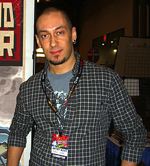 Q: Can you tell us a little about yourself, your background and how you became a comic book artist?
Q: Can you tell us a little about yourself, your background and how you became a comic book artist?A: I'm a comic book artist currently living in Turkey. As with most artists I started out drawing as a kid. I've always been interested in art, and comics have been a part of my life since my earliest memories. As high school came to an end I decided to have education in arts so I've studied Graphic Arts and Animation in university. Meanwhile I started creating comics in fanzines. My work got noticed in time and I started doing work internationally. One thing led to another and I started doing freelance comic work for the bigger comic book companies.
Q: You were born in Turkey, and are obviously proud of your heritage, was it hard breaking in to the American comic book industry being a non-American? Do you think it's necessary to live in America to be an artist for DC Comics or can you work from anywhere in this day and age thanks to the Internet?
A: I think it's been a long and arduous road for me to become internationally recognized as a comic book artist. I don't think it had anything to do with my descent but more due to the lack of direct or easy communication with the business that I wanted to be a part of. Having almost no one else beside myself to point me in the right direction or guide me, I've had to work things out on my own. Luckily the internet came as a savior and made things much easier for everyone. Before the advantages of the internet I had plans of moving out to the US to pursue my dreams but there was no more need for that thanks to the practicality of the internet. You can be anywhere in the world and do your thing just as long as you have a decent connection.
I do believe getting to know people in real life is important if not essential though. So I try to make it to a few conventions every year to get together with my collaborators, editors and fellow creators. Human contact and interaction is one of the more fun and educational parts of this job.
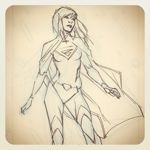 Q: You'd previously been hired to work for DC Comics on the "Brightest Day: Atom" oneshot and an Atom back-up feature in "Adventure Comics", how did you get the job of being the artist on the relaunch of "Supergirl"? What was the process behind that?
Q: You'd previously been hired to work for DC Comics on the "Brightest Day: Atom" oneshot and an Atom back-up feature in "Adventure Comics", how did you get the job of being the artist on the relaunch of "Supergirl"? What was the process behind that?
A: Right after the "Giant-Size Atom" book I started working on "Star Wars: Jedi - The Dark Side". While I was on that DC offered me the chance to do some covers for "Supergirl". This was for the pre-New 52 book. Later I was asked if I'd be interested in doing an ongoing book for them. They were being really vague and after a non-disclosure agreement I was filled in on the details. Turns out I was being offered to be a part of the New 52 with Supergirl. I was pleased as I was looking to do a single character book with a preferably female protagonist.
Q: Some of the criticism directed towards the current "Supergirl" title centered around her going from fight to fight to fight, issue after issue with no real character development (up until the Black Banshee story). How do you react to these comments? And as an artist do you prefer drawing the more action-centric issues or do you prefer the quieter character stories?
A: I would say we started out with the series in a decompressed fashion by design. We wanted to put out an entertaining book with big action while maintaining heart and some intimate character moments. We wanted to show Supergirl, although very alien to us, is someone we can easily empathize with. Although we've had some big fights divided into several issues I believe we've covered a lot of ground with Kara's past while establishing her status on Earth and a good cast of characters surrounding her. We've raised a bunch of questions for which there'll be some answers coming up real soon.
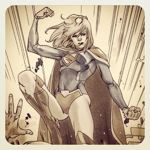 Q: There's always a lot of discussion regarding the sexualization of female characters in comic books. Many feel that the design of Kara's costume in the "New 52" is inappropriate for a teenage girl, especially from the waist down. What are you thoughts on this? And what do you like/dislike most about this version of Supergirl's design?
Q: There's always a lot of discussion regarding the sexualization of female characters in comic books. Many feel that the design of Kara's costume in the "New 52" is inappropriate for a teenage girl, especially from the waist down. What are you thoughts on this? And what do you like/dislike most about this version of Supergirl's design?
A: Truthfully, I completely disagree on this regarding Kara. Sure, there are obviously sexualized or overtly provocative costumes on some characters out there but I don't think Kara fits that category. Kara's costume and its purpose has been hinted at in the first and sixth issues. It's basically a training outfit. If you take a look at modern sports, you'll see that female athletes dress up pretty lightly. So in that sense, or any other sense, I don't think Kara's outfit is sexualized or provocative at all. Admittedly I try to draw her attractive but I aim to keep it tasteful at all times.
Q: In "Superman" Clark's new suit is Kryptonian technology which he took from Brainiac. He can put it on or take it off simply by pressing his S shield and activating it. In the Black Banshee storyline over in "Supergirl", Kara is seen removing her suit like general clothing. Is her suit just fabric or armor like Kal's?
A: Well, before that we have shown Simon Tycho having it tested out in the fourth issue. Unlike Kal's suit, Kara's outfit is a type of indestructible fabric.
Q: When drawing Kara, do you have a particular model or reference photo you work off? Or does her likeness just come to you automatically when you sit down to work on a page?
A: I think it would have been a good idea to have done that but no, I don't have a particular person that Kara's features is based on. I do have a general impression of how she should look in the book since the start. So I try to adhere to that.
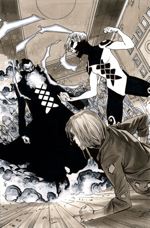 Q: The Black Banshee story line that recently took place in the "Supergirl" title introduced us to a completely different Silver Banshee. Were you given free reign to come up with your own redesign of the Silver Banshee or were there guidelines given to you either by DC Comics or Michael Green and Mike Johnson?
Q: The Black Banshee story line that recently took place in the "Supergirl" title introduced us to a completely different Silver Banshee. Were you given free reign to come up with your own redesign of the Silver Banshee or were there guidelines given to you either by DC Comics or Michael Green and Mike Johnson?
A: Unless they were already designed earlier in other books, I have the freedom to create the looks for every character appearing in the book. So basically everyone except for Supergirl and Superman were entirely visualized by me. I have to say that on some designs I get very specific suggestions from Mike Johnson and Michael Green. Of course our beloved editor, Wil Moss pitches in with great concepts too. For Silver Banshee, I was given certain ideas by the team and worked out some designs on which we had some back and forth discussions on. We pick and choose the best parts and try to come up with good designs.
Q: In your opinion, is the comic industry still a strong business? What advice would you give to upcoming artists looking to break in to the industry?
A: Obviously it's not as widespread as it was many years ago but I feel it's in a very good place right now in terms of what is being put out. Some would say that everything that needs to be said about comics is already said and there's not much else to do. I beg to differ, as I believe this may be the case in some genres or perhaps on certain characters but I feel comics have so much to offer. It's one of the strongest forms of storytelling ever and the possibilities are enormous. Especially nowadays, with the integration of technology and communication, comics are more accessible and diverse.
So getting your work out there is actually the easy part. You can self publish in lots of ways and it will find a following as long as it's good. If one wishes to make it into the mainstream comics, the first step is the same, do good work and have it reach as many people as possible. It will be noticed sooner or later.
As for artistic advice I've never fancied myself a mentor but I would have some suggestions; First and foremost is to face the truths - There are no shortcuts! You have to put in the hard work. Practice will improve your skills and observation will carry you to higher levels. Study from the masters and learn from them. Investigate and imbibe from real life. Comics is a form of storytelling so that should be your ultimate goal; To tell a story and tell it good.
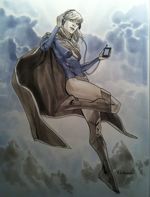 Q: Can you let us in on any upcoming Supergirl storylines you are working on or will soon be working on? What are you most looking forward to?
Q: Can you let us in on any upcoming Supergirl storylines you are working on or will soon be working on? What are you most looking forward to?
A: Right now I'm working on the zero issue. I'll be vague here to avoid getting sliced and diced by the DC legal ninjas but expect quite a few answers on Kara and her origins. It'll be a very gratifying issue for long time readers while being an excellent starting off point. Also we've got some surprising new, but maybe familiar, characters appearing in upcoming issues. You'll never guess who.
Q: Other than "Supergirl" what else are you working on that fans should pick up to check out your work?
A: Right now I'm working on being a good father to my son, so readers should look forward to that. Seriously though I don't have anything else on the horizon at this point except for a personal project that is in the works in a very slow burn.
This interview is Copyright © 2012 by Steven Younis. It is not to be reproduced in part or as a whole without the express permission of the author.
Interviews
Introduction
The Superman Homepage has had the pleasure of interviewing various Superman Comic Book creative people about their work.
Question and Answer Interviews:
- Interview with writer Marv Wolfman about Man and Superman: The Deluxe Edition (November 2019)
- Interview with artist Claudio Castellini about Man and Superman: The Deluxe Edition (November 2019)
- Interview with artist Joe Staton about working on Superman properties over the years (November 2019)
- Interview with Christopher Priest about the Superman vs. Deathstroke story in Deathstroke #8 (November 2016)
- Interview with Sterling Gates about the 'Adventures of Supergirl' digital-first comic book series (January 2016)
- Interview with J. Michael Straczynski about “Superman: Earth One - Vol. 3” - Writer J. Michael Straczynski talks to us about the third volume in the “Superman: Earth One” graphic novel series (February 2015)
- Interview with Jim Krueger - Writer Jim Krueger talks to us about his “The Dark Lantern” story in the “Adventures of Superman” comic book title (November 2013)
- “Smallville: Season 11” Interview with Bryan Q. Miller - Writer Bryan Q. Miller talks to us about his work on the “Smallville: Season 11” comic book title (October 2012)
- “Supergirl” Interview with Mahmud Asrar - Artist Mahmud Asrar talks to us about his work on the monthly “Supergirl” comic book title (July 2012)
- “Superman/Batman” Interview with Joshua Hale Fialkov - Joshua Hale Fialkov answers our questions about “The Secret” 3-part story in “Superman/Batman” #85-87 (July 2011)
- “Supergirl” Interview with Sterling Gates - Sterling Gates answers our questions about where Supergirl is headed post “War of the Supermen” (June 2010)
- “Supergirl” Interview with Sterling Gates & Jamal Igle - Adam Dechanel chats with the “Supergirl” comic book team about the Maid of Might (March 2010)
- Behind the Scenes of the Super Friends - Four part indepth look at the “Super Friends” comic book title with artists J. Bone and Stewart McKenny (February 2010)
- Interview with Landry Q Walker and Eric Jones - The writer and artist discuss Supergirl: Cosmic Adventures in the Eighth Grade (May 2009)
- Interview with Elliot S! Maggin - Legendary Superman writer and novelist discusses his career (January 2009)
- Interview with J. Bone - Artist discusses Super Friends comic book (November 2008)
- Interview with Mark Bagley (September 2008)
- Interview with J. Torres - Writer discusses Legion of Super Heroes in the 31st Century #18 (September 2008)
- Interview with Jake Black (May 2008)
- Interview with Cary Bates (June 2008)
- Interview with Jack Briglio - Writer discusses Legion of Super Heroes in the 31st Century #14 (May 2008)
- Interview with Ken Pontac - Writer discusses Justice League Unlimited #44 (May 2008)
- Interview with Karl Kerschl (April 2008)
- Interview with J. Torres - Writer discusses Legion of Super Heroes in the 31st Century #13 (April 2008)
- Interview with J. Torres - Writer discusses Legion of Super Heroes in the 31st Century #11 (February 2008)
- Interview with Fabian Nicieza - Writer on Superman comic books (June 2007)
- Interview with Danny Fingeroth - Writer of the book Superman on the Couch (May 2007)
- Interview with Jesse McCann - Writer on the Krypto The Superdog comic books (December 2006)
- Interview with Matt Haley - Artist on the Superman Returns comic book movie adaptation (November 2006)
- Interview with Ethan Van Sciver - Artist on Superman/Batman (September 2006)
- Interview with Mark Verheiden on taking over the writing duties on Superman/Batman (April 2006)
- Interview with Matt Idelson on taking over as Superman group editor (March 2006)
- Interview with Jeph Loeb on Sam and “Superman/Batman #26” (February 2006)
- Interview with Roger Stern (December 2005)
- Interview with Marv Wolfman (November 2005)
- Interview with Gail Simone (May 2005)
- Interview with Greg Rucka (April 2005)
- Interview with Brad Meltzer [Identity Crisis] (January 2005)
- Interview with Glenn Whitmore (November 2004)
- Interview with Jeph Loeb (September 2004)
- Interview with Karl Kerschl (September 2004)
- Interview with Ron Garney (September 2004)
- Interview with Greg Rucka and Matthew Clark (May 2004)
- Interview with Ed McGuinness (March 2004)
- Interview with Brad Meltzer [Identity Crisis] (March 2004)
- Interview with Mark Millar [Superman: Red Son] (March 2003)
- Interview with Min S. Ku (September 2001)
- Interview with Jeph Loeb (May 2001)
- Interview with Joe Casey (April 2001)
- Interview with Mike S. Miller (September 2000)
- Interview with Denis Rodier (August 2000)
- Interview with Grant Morrison (December 1999)
- Interview with Mark Millar [Part 2] (November 1999)
- Interview with Mark Millar [Part 1] (April 1999)
Interviews/Articles:
- “Superman vs. Terminator” - A Chat with Fight Promoter Alan Grant. (January 2000)
- Superman: The Dailies (1939-1940) Graphic Novel Review.
- The Rebirth of Superman (Part 1) - Superman is reborn... again.
- The Rebirth of Superman (Part 2) - Eddie Barganza on taking the character in a new direction.
- The Rebirth of Superman (Part 3) - Jeph Loeb discusses writing the Man of Steel.
- Lex Luthor For President - Forget Superman. An updated Luthor's new enemies are Gore and Bush.
- Superman: Last Son of Earth - Steve Gerbern Interview - The writer discusses flip-flopping the Man of Steel's origin. (August 2000)
Krypton Club Interviews:
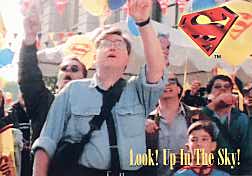 When “Lois & Clark” started production in 1993, there was an obvious relationship between the comic book people and the Hollywood people.
When “Lois & Clark” started production in 1993, there was an obvious relationship between the comic book people and the Hollywood people.
A trade paperback “Lois and Clark: The New Adventures of Superman”, was published, with Dean Cain and Teri Hatcher on the cover. It included reprints of comic book stories that were the inspiration for “Lois & Clark”, helping to define the characters. Comic's included are: The Story of the Century (Man of Steel miniseries #2), Tears for Titano (Superman Annual #1), Metropolis - 900 mi (in SUP #9), The Name Game (SUP #11), Lois Lane (in ACT #600), Headhunter (AOS #445), Homeless for the Holidays (AOS #462), The Limits of Power (AOS #466), and Survival (ACT #665).
A number of comic book writers and artists had roles as extras in the episode “I'm Looking Through You” (Season one, episode 4). Their presence was immortilized in the Sky Trading Card #34.
Craig Byrne, president of the online “Lois & Clark” fanclub The Krypton Club, carried out a series of interviews with comic book writers. The interviews are reprinted with permission of the Krypton Club.
- Interview with Roger Stern (June 1995)
- Interview with John Byrne (June 1995)
- Interview with Mike Carlin (July 1995)
